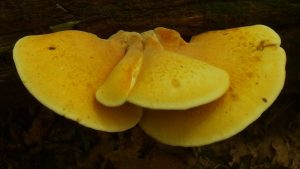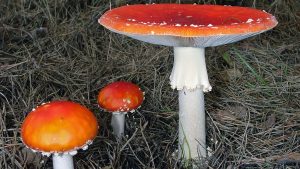#220: Butyriboletus frostii
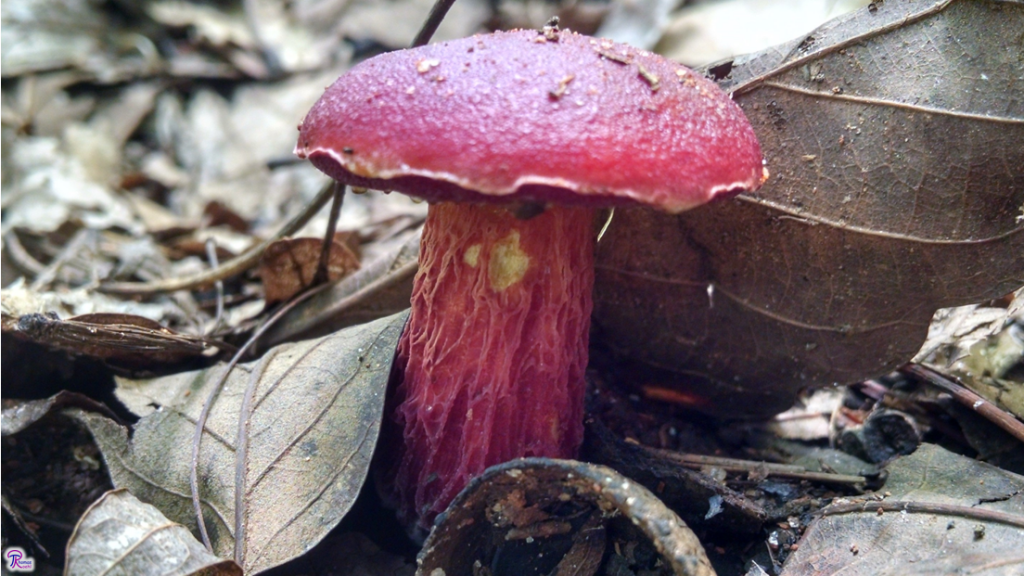
Butyriboletus frostii is a strikingly red bolete with thick reticulation on its stipe. Thanks to its red pores, robust reticulation, and tendency to bruise blue, this bolete cannot be confused with any other.
Boletes are some of the most beautiful mushrooms; their striking color combinations and distinctive textures make the entire group extremely photogenic. One of my favorite boletes to photograph is Butyriboletus frostii, commonly known as the “Candy Apple Bolete” or “Frost’s Bolete.” This mushroom is bright red with yellow and orange layered underneath and has a prominently reticulated stipe. To capture all the beauty of B. frostii, you need to photograph it when it’s young and its red pores are still covered with golden droplets. You may know this mushroom under a different name; when I first learned this mushroom way back in 2015, it was called Boletus frostii. Then its name changed to Exsudoporus frostii before changing again to Butyriboletus frostii, which is the correct name as of this writing in July 2018.1
Description
Butyriboletus frostii has a standard bolete shape: its circular cushion-like pileus sits atop a central stipe. The pileus grows 3.5-8cm across and the stipe grows 4-8cm tall, making it medium-sized for a mushroom.2
The pileus of B. frostii is bright red, about the same color as a ripe apple (thus the common name “Candy Apple Bolete”).1–3 It has a smooth texture but is sticky to slimy when fresh and sometimes features small pockmarks. As the mushroom ages, the red color fades slightly and the pileus may develop yellowish areas. The margin of the pileus hangs down very slightly over the pore surface below.2
When young, the pore surface B. frostii is dark red to pale red, although I usually find that it is darker than the cap. If you find the mushroom in the right conditions, the pore surface will have drops of golden liquid hanging down from it.1–3 If you touch them, the droplets will turn your fingers slightly yellow. The purpose of these droplets is not known; since they are present in many different species – including some polypores – they probably somehow aid in spore dispersal. As the mushroom ages, the pore surface turns brownish red and stops producing liquid. Underneath the surface, the tubes are yellowish to greenish brown and produce an olive-brown spore print.2
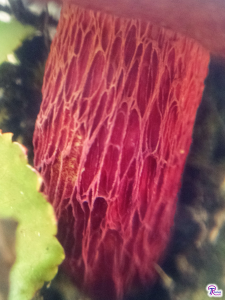
B. frostii is known for its dense reticulation. The stipe and reticulation are usually red, but can be yellow as well.
The mushroom’s stipe is not very thick as bolete stipes go, growing only up to 2cm wide. It maintains roughly the same thickness throughout its length and is mostly straight.2 The entire stipe is covered with a thick layer of reticulum in the form of elongated net-like ridges.1–3 Most of the stipe is red, although it can develop yellowish patches.2 The yellow patches tend to appear in age and are usually beneath the red reticulum. Sometimes the reticulum is also yellow; this tends to occur near the tip of the stipe with the reticulum fading to red down the length of the stipe.1,2
The flesh is whitish to yellowish and usually stains blue immediately when sliced.1–3 Sometimes, the flesh discolors weakly or not at all.1 All other surfaces of the mushroom also stain blue when injured; this reaction is usually rapid and strong.1–3
Ecology
B. frostii is mycorrhizal with hardwoods and is particularly prevalent around oak trees. The mushrooms appear on the ground in woods, usually with a few mushrooms scattered over a small area.2 You can find B. frostii in the summer in eastern North America and Central America. Its range extends east of the Rocky Mountains from New England through Costa Rica, although you can probably find it north and south of those areas.1–3
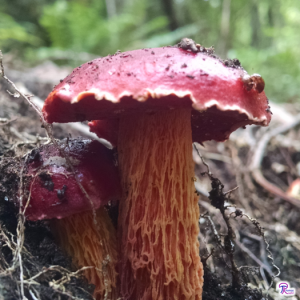
B. frostii has a somewhat slimy cap when young. This is evidenced by the dirt that clings to the mushroom’s pileus long after the slimyness fades.
Similar Species
With its red pores, red cap, and deeply reticulate stipe, nothing else in North America can be mistaken for B. frostii.3 Heimioporus betula (FFF#108) also has a deeply reticulate stipe but features lighter colors and yellow pores.4 The most similar species to B. frostii are Boletus rubroflammeus, B. flammans, B. floridanus, and B. rhodosanguineus (all these species will probably be moved out of Boletus in the near future, possibly to Butyriboletus).5,6 Although these do have reticulate stipes, the reticulation is fine and mostly limited to the upper part of the stipe. The coarse reticulation of B. frostii easily distinguishes it from those species.5
Edibility
In my area (mid-Atlantic United States), you can eat any bolete that 1) does not have red or orange pores, 2) does not stain blue, and 3) is not bitter. B. frostii is one of the exceptions to this rule: it has red pores and stains blue but is still considered edible.1 I find these mushrooms interesting but wouldn’t go out of my way for them. They have a unique sour flavor (in Spanish, they are called “panza agria,” which translates to “sour bellies”) with a hint of bitterness.1 You could probably make a flavorful dish with them, but cooked by themselves I think they are merely OK.
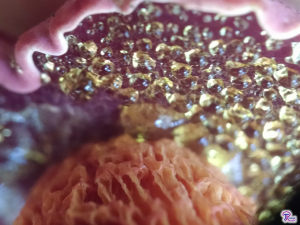
The golden droplets that exude from the pores are beautiful and unique. Other mushrooms also exude liquid from their pores, but B. frostii is the only one I know of where the liquid is yellow.
Taxonomy
Ugh. Bolete taxonomy. Mycologists have taken a keen interest in sorting out this group in recent years. That’s good news, since bolete taxonomy needs a lot of work. Unfortunately, this also means that name changes are common and will happen regularly for the foreseeable future. In the roughly four years that I’ve known Frost’s Bolete, it has been placed in three different genera. It began in Boletus, which contained most boletes. That genus is being dismantled and will eventually contain only those species that are closely related to Boletus edulis (the “King Bolete”, “Porcini”, “Penny Bun” etc.). The mushroom was then moved to Exsudoporus, a genus erected specifically for the distinctive Frost’s Bolete. However, further research revealed that it was closely related to the mushrooms in Butyriboletus (the “butter boletes”) and deserved to reside in that genus.1 For now, the mushroom’s correct name is Butyriboletus frostii,7 although I would not be surprised if it changed again in the future. The species name pays homage to 19th century American botanist Charles Christopher Frost, who was noted for his contributions to the study of American boletes.
| Kingdom | Fungi |
| Subkingdom | Dikarya |
| Division (Phylum) | Basidiomycota |
| Subdivision (Subphylum) | Agaricomycotina |
| Class | Agaricomycetes |
| Subclass | Agaricomycetidae |
| Order | Boletales |
| Family | Boletaceae |
| Genus | Butyriboletus |
| Species | Butyriboletus frostii (J.L. Russell) G. Wu, Kuan Zhao & Zhu L. Yang7 |
This post is not part of a key and therefore does not contain enough information to positively identify any mushroom. When collecting for the table, always use a local field guide to identify your mushrooms down to species. If you need a quality, free field guide to North American mushrooms, I recommend Michael Kuo’s MushroomExpert.com. Remember: when in doubt, throw it out!
See Further:
http://www.mushroomexpert.com/boletus_frostii.html
https://boletes.wpamushroomclub.org/product/boletus-frostii/#prettyPhoto[product-gallery]/0/
Citations
- Butyriboletus frostii (“Candy Apple Bolete”). The Bolete Filter (2015).
- Kuo, M. Boletus frostii. MushroomExpert.Com (2013). Available at: http://www.mushroomexpert.com/boletus_frostii.html. (Accessed: 27th July 2018)
- Halling, R. E. & Mueller, G. M. Boletus frostii Russell. Macrofungi of Costa Rica Available at: https://www.nybg.org/bsci/res/hall/frostii.html. (Accessed: 27th July 2018)
- Kuo, M. Heimioporus betula. MushroomExpert.Com (2010). Available at: http://www.mushroomexpert.com/heimioporus_betula.html. (Accessed: 27th July 2018)
- Kuo, M. Boletus rubroflammeus. MushroomExpert.Com (2014). Available at: http://www.mushroomexpert.com/boletus_rubroflammeus.html. (Accessed: 27th July 2018)
- Boletus floridanus. Mycobank Available at: http://www.mycobank.org/Biolomics.aspx?Table=Mycobank&Rec=282973&Fields=All. (Accessed: 27th July 2018)
- Butyriboletus frostii. Mycobank Available at: http://www.mycobank.org/BioloMICS.aspx?TableKey=14682616000000067&Rec=555583&Fields=All. (Accessed: 27th July 2018)

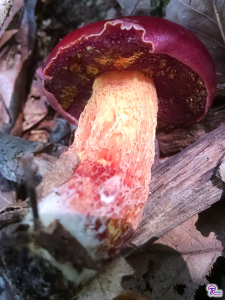

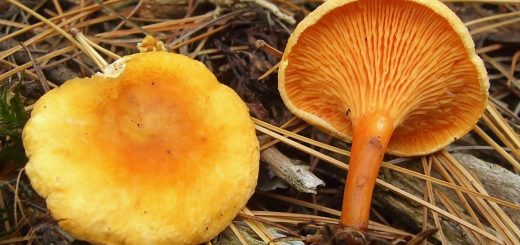





![#011: Characteristics of Kingdom Fungi [Archived]](https://www.fungusfactfriday.com/wp-content/themes/hueman/assets/front/img/thumb-small-empty.png)

